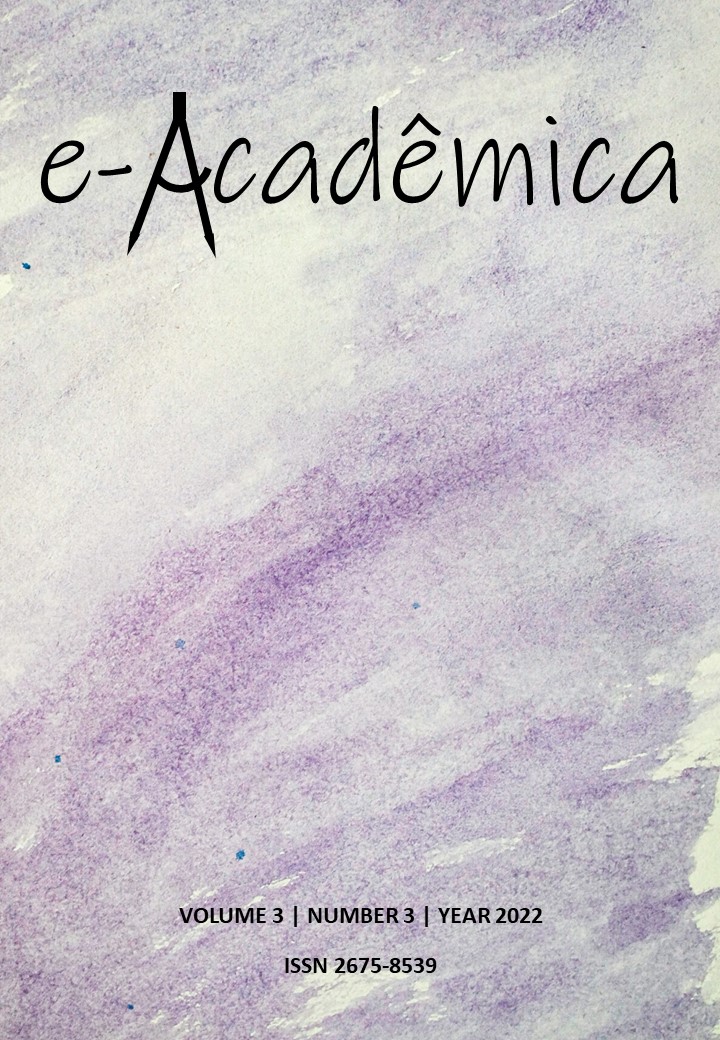Unilateral fracture of mandibular condyle: clinical-surgical case report
DOI:
https://doi.org/10.52076/eacad-v3i3.275Keywords:
Mandibular condyle; Mandibular fractures; Oral surgery.Abstract
Mandibular fractures can lead to anatomical and aesthetic changes in the face as well as alter masticatory, phonation, swallowing and emotional functions in the patient. The mandible is considered the only mobile bone of the face and is susceptible to fractures due to its anatomy, and the condyle region is commonly affected by indirect trauma in the mandibular symphysis region. Condylar fractures present a large number of controversies regarding their diagnosis and best treatment method, since several factors influence the choice of surgical or conservative approach. Accidental falls from standing height, car accidents, physical and sports aggression are the main etiological factors associated with condylar fractures. This study aims to describe the case of a patient who fell from his own height, presenting signs and symptoms such as edema in the mandibular symphysis region, malocclusion and deviation in mouth opening to the left side, being diagnosed after complementary exams with unilateral fracture of the mandibular condyle that, after having received surgical treatment to reduce the fracture, evolved to an excellent aesthetic and functional result. The choice for the treatment of this fracture was surgical treatment with internal fixation of the condylar fracture with a 2.0mm system.
References
Akabane, S. T. F., Santos, G. M. dos, Reis, E. N. R. de C., Pires, W. R., Polo, T. O. B., Faverani, L. P., Souza, F. Ávila, & Ponzoni, D. (2017). Relato de caso raro: fratura bilateral de côndilo e sínfise mandibular. Archives of health investigation, 5(8), 1-5.
Barbosa, M. R., Martorelli, S. B. F, Menezes, M. R. A., Silva, C. C. G, Cunha, J. S., Diniz, D. A. & Mendonça, TLR (2020). Tratamento conservador versus revisão cirúrgica das fraturas condicionais: integrativa. Pesquisa, Sociedade e Desenvolvimento, 4(10), 1-6.
Batista, A. V. S., et. al. (2021). Estudo observacional de pacientes com fraturas de côndilo occipital em centros de referência em trauma no brasil. Revista colégio brasileiro de cirurgia, 1(5), 1-6
Fernandes, B. R, Marchiori, D. L., dos Santos, G. M., Paino-Sant’Ana, A., da Silva, R. C., de Lima, D., & dos Santos Pereira, R. (2021). Estratégia cirúrgica para tratamento de fratura de côndilo mandibular. Archives of Health Investigation, 10(5), 844-847.
Filho, E. F.A., Fadul Jr, R., Azevedo, R. D. A., Da Rocha, M. A. D., Santos, R. D. A., Toledo, S. R., & Ferreira, L. M. (2000). Fraturas de mandíbula: análise de 166 casos. Revista da Associação Médica Brasileira, 46(3), 272-276.
Fonseca, R. J., Walker, R. J., Barber, H. D., Powers, M. P., & Frost, D. E. (2015). Trauma bucomaxilofacial. Elsevier Brasil, 100-800.
Kumaran, S., & Thambiah, L. J. (2012). Analysis of two different surgical approachesfor fractures of the mandibular condyle. Indian Journal Of Dental Research, 23(4), 463-468.
Lopes, R., Martins, L., Horikawa, F. K., Snidei, I. R. M., & Shinohara, E. H. (2017). Pseudoartrose mandibular: estudo de caso e tratamento cirúrgico. Archives of Health Investigation, 6(1) 4-9.
Manganello, L. C., & Silva, A. A. F. (2002). Fraturas do côndilo mandibular: classificação e tratamento. Revista Brasileira Otorrinolaringologista, 68(5),749-55.
Miloro, M. (2008). Princípios de cirurgia bucomaxilofacial de Peterson. Princípios de cirurgia bucomaxilofacial de Peterson, 766-796.
Miloro, M. (2016). Princípios de Cirurgia Bucomaxilofacial de Peterson (3ª ed.), 560-650.
Pavelski, M. D., Marins, B. R., Griza, G. L., Conzi, R. A., Érinca, N. M., Júnior, E. A. G. (2018). Análise de fraturas de côndilo mandibular – um estudo retrospectivo. Rev port estomatol med dent cir maxilofac, 59(2) 94-99.
Pech, G. L. (2019). Manejo das fraturas de condilo mandibular. Universidade de Caxias do Sul. 2(5) 56-59.
Rampaso, C. L., Mattioli, T. M. F., Sobrinho, J. A., & Rapoport, A. (2009). Estudo epidemiológico das fraturas do côndilo da mandíbula. Revista Brasileira de Cirurgia Cabeça e Pescoço, 38(1),19-21.
Rodrigues, R. D., Quintas, P. H., da Silva Barreto, L., Costa, C. F. B., Silva, L. O. R., & Aguiar, J. F. (2018). Manejo cirúrgico de fratura de mandíbula: relato de caso. Revista Da Faculdade de Odontologia-UPF, 23(3), 343-347.
Rodrigues, C. M. C.; Santos, D. M.; Oliveira, M. M. M.; Silva, M. C. P., Furtado, M. L. (2019). Revista Odontológica do Brasil central, 5(28), 87-90.
Sarmento, D. J. S, Cavalcanti, A. L., & dos Santos, J. A. (2007). Características e distribuição das fraturas mandibulares por causas externas: estudo retrospectivo. Pesquisa Brasileira em Odontopediatria e Clínica Integrada 2(2), 139-144.
Sharif, M. O., Fedorowicz, Z., Drews, P., Nasser, M., Dorri, M., Newton, T., & Oliver, R. (2010). Interventions for the treatment of fractures of the mandibular condyle. Cochrane Data base of Systematic Reviews 2010. 2(66), 120-126.
Silva, F. M. (2005). Avaliação pré-operatória do paciente odontológico: aspectos clínicos, laboratoriais e radiológicos. Revinter, 1ed, 124p.
Silva, J. S., Beiriz, R. K. A., Júnior, M. A. B., Bessa-Nogueira, R. V., Araujo, M. M. & Vasconcellos, R. J. H. (2020). Fixação interna estável de fratura condilar: relato de caso. Arch Health Invest, 9(6), 541-545
Silva, A. P., Antunes, J. L. F., & Cavalcanti, M. G. P. (2003). Interpretação das fraturas do côndilo mandibular usando tomografia computadorizada 2D e 3D. Revista Brasileira de Odontologia, 14 (3), 203-208.
Trento, G. S., Corso P. F. C. L., Oliveira, N. D., Klüppel, L. E., Costa, D. J., Rebellato, N. L. B. & Scariot, R. (2016). Surgical treatment of mandibular condyle fracture with bicortical screws: case report. RSBO, 13(1), 50-4
Vieira, W. M., Siqueira, O. V., Scherma, A. P., & Miranda, L. R. (2011). Fratura bilateral de côndilo mandibular: tratamento tardio e complicações. Rev Bras CirCraniomaxilofac, 14(2), 115-118.
White, S. C., & Pharoah, M. J. (2007). Radiologia oral: fundamentos e interpretações. Elsevier ,724p.
Downloads
Published
How to Cite
Issue
Section
License
Copyright (c) 2022 Gustavo Paiva Custódio; Cesar Feitoza Bassi Costa; Carlos Henrique Silveira de Castro; Liz Carneiro Queiroz; Rafaela de Oliveira Conceição; Alef Vieira Galvão; Marcelo de Carvalho Almeida; Gabriel Marchiori Galani; Isabela Pulino Padilha; Thaisláyne Mirelle dos Santos Cruz; Kall Anderson de Oliveira; Daniel Adorno Alves; Jaqueline Chagas Vieira; Willian Ahumada Bento Ayres; Túrya Souza Teixeira ; Keni Alves de Paula

This work is licensed under a Creative Commons Attribution 4.0 International License.
Autores que publicam nesta revista concordam com os seguintes termos:
1) Autores mantém os direitos autorais e concedem à revista o direito de primeira publicação, com o trabalho simultaneamente licenciado sob a Licença Creative Commons Attribution que permite o compartilhamento do trabalho com reconhecimento da autoria e publicação inicial nesta revista.
2) Autores têm autorização para assumir contratos adicionais separadamente, para distribuição não-exclusiva da versão do trabalho publicada nesta revista (ex.: publicar em repositório institucional ou como capítulo de livro), com reconhecimento de autoria e publicação inicial nesta revista.
3) Autores têm permissão e são estimulados a publicar e distribuir seu trabalho online (ex.: em repositórios institucionais ou na sua página pessoal) a qualquer ponto antes ou durante o processo editorial, já que isso pode gerar alterações produtivas, bem como aumentar o impacto e a citação do trabalho publicado.










